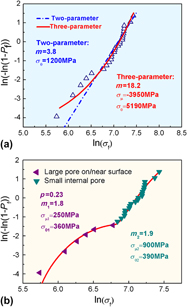Crossref Citations
This article has been cited by the following publications. This list is generated based on data provided by
Crossref.
Deibler, Lisa A.
and
Lewandowski, John J.
2012.
Outer medium effects and fracture nucleation sites in model experiments to mimic fracture surface features of metallic glasses.
Materials Science and Engineering: A,
Vol. 538,
Issue. ,
p.
259.
Wang, Shao-Gang
Sun, Ming-Yue
Song, Zhen-Qiang
and
Xu, Jian
2012.
Cast defects induced sample-size dependency on compressive strength and fracture toughness of Mg–Cu–Ag–Gd bulk metallic glass.
Intermetallics,
Vol. 29,
Issue. ,
p.
123.
Deng, J.W.
Du, K.
Wu, B.
and
Sui, M.L.
2013.
Nanometer to micrometer scaled inhomogeneous etching of bulk metallic glasses by ion sputtering.
Intermetallics,
Vol. 34,
Issue. ,
p.
75.
Liu, Z. Q.
and
Zhang, Z. F.
2013.
Mechanical properties of structural amorphous steels: Intrinsic correlations, conflicts, and optimizing strategies.
Journal of Applied Physics,
Vol. 114,
Issue. 24,
Wang, X.
Shao, Y.
Gong, P.
and
Yao, K.F.
2013.
The effect of simulated thermal cycling on thermal and mechanical stability of a Ti-based bulk metallic glass.
Journal of Alloys and Compounds,
Vol. 575,
Issue. ,
p.
449.
Wang, Xiao-dong
Wang, Huan
Shen, Hong-xian
Qin, Fa-xiang
Xing, Da-wei
Liu, Jing-shun
Chen, Dong-ming
and
Sun, Jian-fei
2014.
Tensile properties and fracture reliability of a glass-coated Co-based amorphous microwire.
International Journal of Minerals, Metallurgy, and Materials,
Vol. 21,
Issue. 6,
p.
583.
Cohades, Amaël
and
Mortensen, Andreas
2014.
Tensile elongation of unidirectional or laminated composites combining a brittle reinforcement with a ductile strain and strain-rate hardening matrix.
Acta Materialia,
Vol. 71,
Issue. ,
p.
31.
Neilson, Henry J.
Petersen, Alex S.
Cheung, Andrew M.
Poon, S. Joseph
Shiflet, Gary J.
Widom, Mike
and
Lewandowski, John J.
2015.
Weibull modulus of hardness, bend strength, and tensile strength of Ni−Ta−Co−X metallic glass ribbons.
Materials Science and Engineering: A,
Vol. 634,
Issue. ,
p.
176.
Shen, Hongxian
Xing, Dawei
Wang, Huan
Liu, Jingshun
Chen, Dongming
Liu, Yanfen
and
Sun, Jianfei
2015.
Tensile Properties and Fracture Reliability of Melt-extracted Gd-rich Amorphous Wires.
Materials Research,
Vol. 18,
Issue. suppl 1,
p.
66.
Andersen, Laura M.
Hofmann, Douglas C.
and
Vecchio, Kenneth S.
2016.
Effect of zirconium purity on the glass-forming-ability and notch toughness of Cu43Zr43Al7Be7.
Materials Science and Engineering: A,
Vol. 674,
Issue. ,
p.
397.
Sun, Haichao
Ning, Zhiliang
Wang, Gang
Liang, Weizhong
Shen, Hongxian
Sun, Jianfei
and
Xue, Xiang
2016.
Tensile Strength Reliability Analysis of Cu48Zr48Al4 Amorphous Microwires.
Metals,
Vol. 6,
Issue. 12,
p.
296.
Gulzar, A.
Zhu, Z.G.
Shahzad, K.
Zhao, D.Q.
and
Wang, W.H.
2016.
Flow units perspective on sensitivity and reliability of metallic glass properties.
Intermetallics,
Vol. 69,
Issue. ,
p.
98.
Wang, Xin
Gong, Pan
and
Yao, Ke-Fu
2016.
Mechanical behavior of bulk metallic glass prepared by copper mold casting with reversed pressure.
Journal of Materials Processing Technology,
Vol. 237,
Issue. ,
p.
270.
Zhang, Jijun
Estévez, Diana
Zhao, Yuan-Yun
Huo, Lishan
Chang, Chuntao
Wang, Xinmin
and
Li, Run-Wei
2016.
Flexural Strength and Weibull Analysis of Bulk Metallic Glasses.
Journal of Materials Science & Technology,
Vol. 32,
Issue. 2,
p.
129.
Li, Yu
and
Xu, Jian
2017.
Role of late transition metals on pitting resistance of Zr-Ti-(Cu, Ni, Co)-Al bulk metallic glasses in 0.6 M NaCl aqueous solution.
Journal of Materials Science & Technology,
Vol. 33,
Issue. 11,
p.
1278.
Krämer, Lisa
Champion, Yannick
and
Pippan, Reinhard
2017.
From powders to bulk metallic glass composites.
Scientific Reports,
Vol. 7,
Issue. 1,
Bertolla, Luca
Dlouhý, Ivo
Tatarko, Peter
Viani, Alberto
Mahajan, Amit
Chlup, Zdeněk
Reece, Michael J.
and
Boccaccini, Aldo R.
2017.
Pressureless spark plasma–sintered Bioglass ® 45S5 with enhanced mechanical properties and stress–induced new phase formation.
Journal of the European Ceramic Society,
Vol. 37,
Issue. 7,
p.
2727.
Li, Xiaoyu
Jiang, Liangbao
Wang, Yi
Mohagheghian, Iman
Dear, John P.
Li, Lei
and
Yan, Yue
2017.
Correlation between K+-Na+ diffusion coefficient and flexural strength of chemically tempered aluminosilicate glass.
Journal of Non-Crystalline Solids,
Vol. 471,
Issue. ,
p.
72.
Qu, R.T.
Wang, S.G.
Wang, X.D.
Wu, S.J.
and
Zhang, Z.F.
2019.
Shear band fracture in metallic glass: Sample size effect.
Materials Science and Engineering: A,
Vol. 739,
Issue. ,
p.
377.
Ma, Yunfei
Tang, Xuefeng
Wang, Xin
Zhang, Mao
Hu, Huie
Gong, Pan
and
Wang, Xinyun
2021.
Preparation and mechanical properties of tungsten-particle-reinforced Zr-based bulk-metallic-glass composites.
Materials Science and Engineering: A,
Vol. 815,
Issue. ,
p.
141312.



